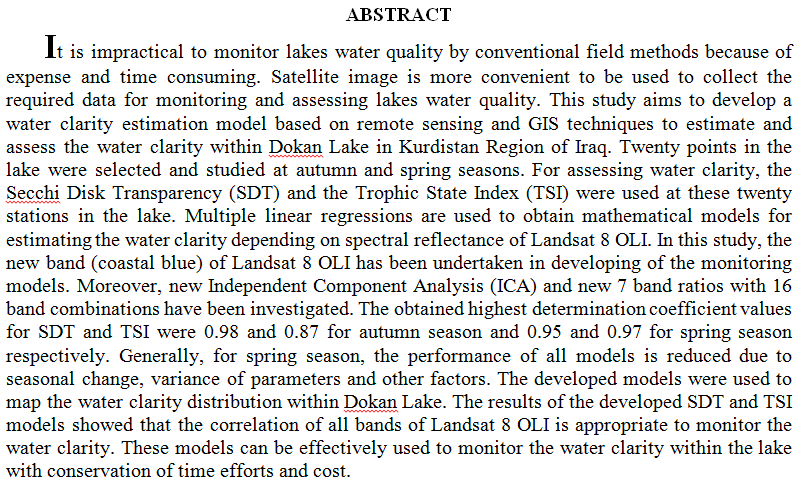
The gamma dose rates and specific activity of 137Cs, 60Co and 40K in
samples of soil taken from places near the landfill radiation at Al-
Tuwaitha site were measured using a portable NaI(Tl) detector. The
results of gamma dose rates in samples were ranged from 52.6
nGy.h-1 to 131nGy.h-1. Then the specific activity of 137Cs, 60Co and
40K in soil were determined using high pure germanium (HPGe)
detector. The specific activities were varied from 1.9 to 115500 Bq.
kg-1 for 137Cs, from 6.37 to 616.5 Bq. kg-1 for 60Co, and from 3 to
839.5 Bq. kg-1 for 40K. The corresponding health risk for the annual
effective dose equivalent varied from 1.85×10-14 to 15.7mSv/y. The
results were compared with various internationa
Background: 37% phosphoric acid (PA) is the traditional enamel etching technique prior to bracket adhesion, yet it has been implicated in numerous enamel injuries. The purpose of the current study was to create a calcium phosphate (CaP) etching paste in a simplified capsule formula that can underpin clinically adequate bracket bond strength without jeopardizing the integrity of enamel upon the debracketing procedure. Materials and Methods: micro-sized hydroxyapatite (HA) powder was mixed with 40% PA solution to prepare experimental acidic CaP paste. Sixty human premolars were assigned into two groups of 30 each. Enamel conditioning was accomplished using 37% PA-gel for control group and CaP paste for e
... Show More (6)
(6)
 (4)
(4)
Objective: To assess of Science Teachers' Awareness towards Communicable Diseases Control in Baghdad City
Primary Schools
Methodology: A descriptive study was conducted, included (100) primary school, (50) in Al-Rassafa sector, and
(50) in Al-Karkh sector, from March 5th 2012 to March 15th 2013, to assess of science teachers' awareness
towards communicable diseases control. A cluster sample of (100) Science teachers (males and females) were
selected, as one teacher from each school. A questionnaire format was used for data collection. The validity of
questionnaire was estimated through a penal of experts related to the field of study, and its reliability was
estimated through a pilot study conducted in (20) schools (
 (16)
(16)
 (14)
(14)
 (41)
(41)
 (36)
(36)
 (7)
(7)
 (9)
(9)
Sediment samples were collected from main water processing and supply plants in Baghdad, and tested for radioactivity from both natural and artificial sources. These stations are: East Dijla (Tigris), Al-Kadisia, Al-Karama, Al-Rasheed, Al-Sader, Al-Wathba, and Al-Wihda supply stations. Qualitative measurements were made, and the results showed that most sediments exhibited natural radioactive level and sometimes less than the international regular standards. Specially, K-40 and Ra-226 results were much less than the standards for radioactive concentrations. Ac-228 concentration was found rather than Th-232 (in Al-Sader and Al-Wihda samples) but with low concentrations of about 10-15 Bg/kg and detection confidence ~45% , and Ce-141 and Be
... Show MoreTurbidity is a visual property of water that expresses the amount of suspended substances in the water. Its presence in quantities more significant than the permissible limit makes the water undrinkable and reduces the effectiveness of disinfectants in treating pathogens. On this basis, turbidity is used as a basic indicator for measuring water quality. This study aims to evaluate the removal efficiency of AL- Muthanna WTP. Water turbidity was used as a basic parameter in the evaluation, using performance improvement evaluation and data from previous years (2016 to 2020). The average raw water turbidity was 26.7 NTU, with a minimum of 14 NTU, with a maximum of 48 NTU. Water turbidity value for 95% of settling daily reading data was
... Show More (5)
(5)
Turbidity is a visual property of water that expresses the amount of suspended substances in the water. Its presence in quantities more significant than the permissible limit makes the water undrinkable and reduces the effectiveness of disinfectants in treating pathogens. On this basis, turbidity is used as a basic indicator for measuring water quality. This study aims to evaluate the removal efficiency of AL- Muthanna WTP. Water turbidity was used as a basic parameter in the evaluation, using performance improvement evaluation and data from previous years (2016 to 2020). The average raw water turbidity was 26.7 NTU, with a minimum of 14 NTU, with a maximum of 48 NTU. Water turbidity value for 95% of settling daily readi
... Show More (5)
(5)
Direct contact membrane distillation is an effective method for production of fresh water from saline water. In this study two samples were used as feed solutions; the first one was RO waste from Al-Hilla Coca-Cola Factory (TDS= 2382 mg/l) and the other was Haji Ali drainage water (TDS= 4127 mg/l). Polytetrafluoroethylene (PTFE) hydrophobic membrane supported with polypropylene (PP) was used as flat sheet form with plate and frame cell. Results proved that membrane distillation is an effective technique to produce fresh water with high quality from brine with low salinity content. With membrane area of 8x8 cm2, the volume of treated water decreased from 34.97 ml at first half hour to 33.02 ml after 180 min of
... Show More